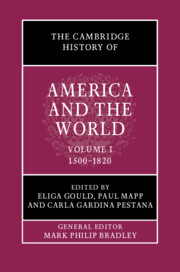Book contents
- The Cambridge History of America and the World
- The Cambridge History of America and the World
- The Cambridge History of America and the World
- Copyright page
- Contents
- Figures
- Maps
- Contributors to Volume I
- General Introduction: What is America and the World?
- Introduction: What Does America and the World “Mean” before 1825?
- Part I Geographies
- 1 Changing American Geographies
- 2 Maritime Borderlands
- 3 The Americas and the Contested Aquatic World of the Atlantic, Indian, and the Pacific Oceans
- 4 Extractive Industries and the Transformation of American Environments
- Part II People
- Part III Empires
- Part IV Circulation/Connections
- Part V Institutions
- Part VI Revolutions
- Index
4 - Extractive Industries and the Transformation of American Environments
from Part I - Geographies
Published online by Cambridge University Press: 12 November 2021
- The Cambridge History of America and the World
- The Cambridge History of America and the World
- The Cambridge History of America and the World
- Copyright page
- Contents
- Figures
- Maps
- Contributors to Volume I
- General Introduction: What is America and the World?
- Introduction: What Does America and the World “Mean” before 1825?
- Part I Geographies
- 1 Changing American Geographies
- 2 Maritime Borderlands
- 3 The Americas and the Contested Aquatic World of the Atlantic, Indian, and the Pacific Oceans
- 4 Extractive Industries and the Transformation of American Environments
- Part II People
- Part III Empires
- Part IV Circulation/Connections
- Part V Institutions
- Part VI Revolutions
- Index
Summary
In the early modern period, extractive industries were the vanguard of European colonization in America. Whether involving the removal of minerals, flora, fauna, or other organic or inorganic materials, these ventures attracted enterprising Europeans hoping to profit from bringing natural resources out of newly accessible lands and into the expanding currents of international trade. Establishing a viable extractive industry – such as mining, logging, fishing, hunting animals, or collecting plants – proved a critical preliminary component of many settlement schemes by helping to generate the capital needed to underwrite their initial development and, ideally, by contributing to their ongoing productivity. Although the results were uneven, European powers, especially Spain, England, France, and the Netherlands, sought to parlay their subjects’ involvement in various American extractive industries to produce national wealth, claim sovereignty over new lands, justify the exploitation of subaltern populations, and lay the groundwork for more extensive imperial expansion. Whether as the foundations of new commodity frontiers or as the precursors to other forms of colonial development, extractive industries reshaped many regions in the Americas, often with dire outcomes for their Indigenous inhabitants and natural environments.
- Type
- Chapter
- Information
- The Cambridge History of America and the World , pp. 96 - 114Publisher: Cambridge University PressPrint publication year: 2022



